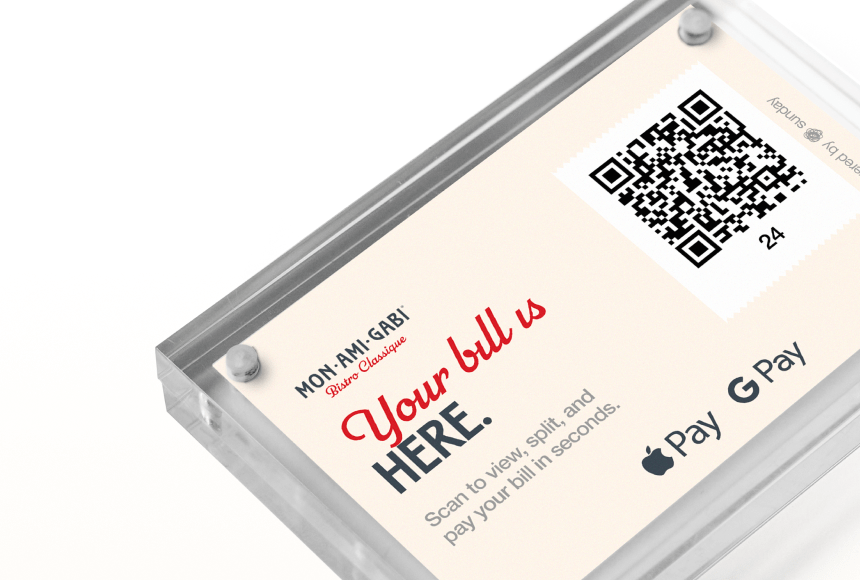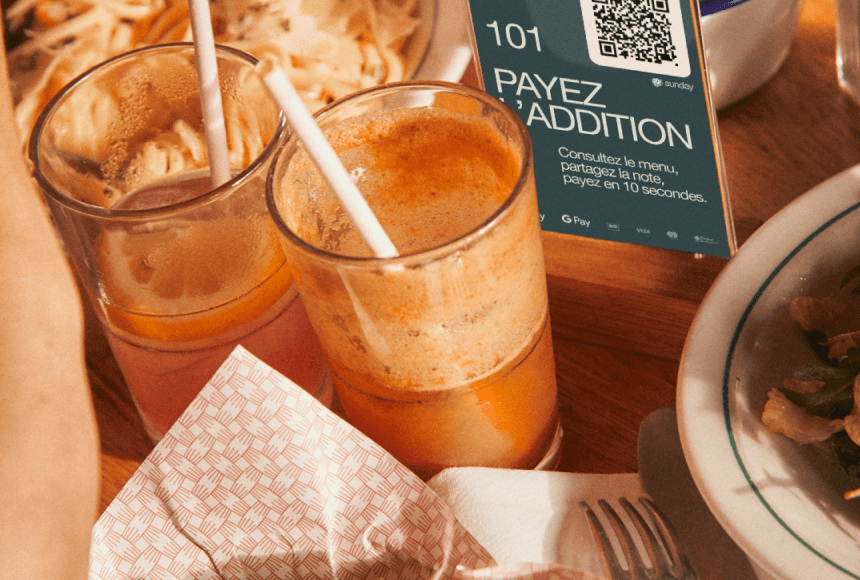
How a Smart Card Reader Can Revolutionize Your Restaurant
From Simple Card Readers to All-In-One Smart Terminals
A few years ago, a standard card reader—sometimes called a TPE in French, or a “smart terminal” / “smart handheld” in the US—was merely a functional device for swiping or dipping credit cards. Times have changed. Modern restaurants now crave technology that does more than process payments; they want solutions that streamline operations, enhance customer experiences, and provide actionable insights.
According to the National Restaurant Association, more than half of U.S. restaurants have recently adopted or upgraded to some form of “smart” payment system. Why? Because a standalone card reader can no longer keep up with evolving diner expectations. Today’s guests want seamless service—fast, secure payments at the table, digital receipts, and the ability to handle complex requests like splitting checks or applying loyalty rewards without hassle.
If your restaurant still relies on a dated point-of-sale (POS) or a bare-bones card machine, you might be missing opportunities to increase revenue, boost efficiency, and make each customer interaction memorable. Let’s explore the biggest advantages that a smart terminal (also known as an intelligent TPE) can bring to your establishment—and how this technology can transform the way you run your restaurant.
1. Faster, More Convenient Checkout
The days of passing around a clunky payment machine or walking back and forth to a stationary POS should be behind us. With a smart terminal, servers can settle checks directly at the table, letting guests pay without waiting for card swipes or signatures to cycle through a busy front-of-house area.
Why this matters:
- Reduced Wait Times: The difference between a 10-minute exit and a 2-minute exit is significant. When diners are ready to leave, they appreciate immediate, frictionless payment.
- Higher Table Turnover: Faster checkouts often mean tables can be cleared and re-seated more quickly, allowing you to serve more guests during peak hours.
- Better Customer Impressions: Diners remember if their final moments at your restaurant were smooth or bumpy. Convenient payment can leave a positive last impression that boosts loyalty.
In an industry where timely service can make or break a lunch rush, every minute counts. Embracing a modern card reader or handheld that handles payments swiftly helps ensure no one’s left awkwardly waving their card in the air.
2. Multiple Payment Options in One Device
Today’s diners use a variety of payment methods—cash, credit, debit, mobile wallets, contactless cards, and even QR code-based solutions. A smart terminal unifies all of these into a single hub:
- Contactless and NFC: Tap-to-pay with phone wallets (Apple Pay, Google Pay) or near-field communication credit cards. No extra equipment needed.
- Chip and Swipe: Serve the segment of customers with chip-based EMV cards (the secure gold standard in the U.S.) or traditional magnetic stripes.
- QR Integration: Some smart terminals let diners scan a code on the device or on the check to finalize payment on their phone—blending app-based convenience with device-based oversight.
By supporting multiple methods, you ensure your restaurant never turns away potential revenue because you “can’t take that card” or “don’t accept that wallet.” The best part? Your staff doesn’t juggle separate gadgets or adapt to multiple workflows—everything runs through the same, user-friendly interface.
3. Enhanced Security and Fraud Protection
Card data breaches and fraud remain major concerns for both restaurateurs and guests. The good news? Smart terminals are designed with security front and center. Features include:
- EMV Compliance: Equipped for chip-and-PIN or chip-and-signature, significantly reducing counterfeit card fraud.
- Encrypted Transactions: End-to-end encryption ensures card details are never stored in plain text on your systems, mitigating data-theft risks.
- Biometric or PIN Access for Staff: Some handhelds require a server’s fingerprint or PIN to process refunds or voids, preventing inside theft or accidental charges.
Ultimately, secure technology fosters trust. Guests feel comfortable handing over their payment info when they see your restaurant employs up-to-date solutions, and they’ll be more willing to return—knowing you prioritize their financial safety.
4. Tableside Ordering and Real-Time Menu Updates
Many next-generation card readers aren’t just about payment—they can also display an interactive digital menu. This dual purpose allows:
- Tableside Ordering: Servers or guests themselves can add items to the check on the device, removing the need for scribbled notes or memorized orders.
- Auto-Synced Changes: If you run out of a daily special, the device updates instantly—preventing a server from mistakenly offering an out-of-stock dish.
- Clear Allergen and Ingredient Info: Interactive menus can highlight allergen data or suggestions for pairings, helping diners feel confident in their choices.
This synergy between ordering and payment drastically reduces errors—what the diner taps is what gets sent to the kitchen. Fewer mistakes lead to happier customers, improved efficiency, and less wastage of time or ingredients.
5. Boosting Tips and Gratuities
Let’s talk about tips. The interface on a smart terminal can nudge diners toward fair tipping, typically increasing the average gratuity your staff receives:
- Polite Tip Suggestions: Diners see recommended percentages (e.g., 15%, 20%, 25%) or a custom field. This gentle prompt normalizes tipping in the chosen range, supporting servers without feeling pushy.
- Streamlined UI: A quick “Add Tip” screen that’s just a tap away means diners don’t have to ask awkward questions or do mental math on the spot.
- Visible Confirmation: Staff can see in real-time what was tipped, reducing confusion over whether a diner left enough or forgot altogether.
In fact, many restaurants report a measurable tip increase with digital devices compared to paper slips. It’s a win-win: servers appreciate higher gratuities, and diners enjoy a quick, transparent process.
6. Simplified Check Splitting and Group Payments
When four or five friends dine together, splitting the bill can get messy—especially if some want to split equally, while others prefer itemized splits or separate checks. Smart terminals handle these complexities with ease:
- One-Click Item Assignments: The device or staff can drag items to each diner’s “tab,” ensuring each person pays for what they ordered—no guesswork or disputes.
- Partial Splits: If a couple wants to share half the bill and the others handle their own, it’s easily done. The terminal calculates each portion automatically.
- Multiple Payment Methods: Some diners may pay by card, others by a mobile wallet, and the last with a gift card. The terminal accommodates every preference, generating separate receipts as needed.
This group-friendly approach is a major relief. Larger parties often dread that final awkward dance with calculators, paper checks, and staff re-runs. A streamlined system helps them leave satisfied—and more likely to return for group outings.
7. Loyalty Program Integration
A robust loyalty program can make the difference between a one-time diner and a regular. However, if the sign-up process is complicated or separate from the payment moment, many guests opt out. A modern smart terminal can integrate loyalty features directly into the checkout flow:
- Instant Enrollment: New diners can join by tapping “Sign Up” on the terminal, often just needing an email or phone number.
- Point Redemption: Regulars see how many points they’ve accrued and can decide whether to redeem them for a discount, free appetizer, or other reward on the spot.
- Personalized Offers: If the terminal recognizes a loyalty member’s card, it can surface relevant upsells or special deals—like a birthday drink or limited-time coupon.
Bundling loyalty with payment encourages higher participation: it’s quick, convenient, and in the same place diners are already looking—the payment screen. That fosters a deeper bond between your brand and your best customers.
8. Real-Time Data and Improved Operations
Most traditional card readers simply relay payment amounts to a bank or third-party processor. In contrast, smart terminals gather real-time data that can feed into your point-of-sale and analytics tools:
- Instant Sales Tracking: Management sees up-to-the-minute revenue, average ticket size, and payment breakdowns—helpful for adjusting staffing mid-shift or reordering popular inventory items.
- Peak Time Insights: Pinpoint precisely when guests pay or how quickly tables turn, letting you optimize staffing schedules or marketing campaigns around busy periods.
- Payment Preference Trends: Do your clientele favor Apple Pay? Do younger diners lean toward QR code scans? Having these metrics can shape your promotional strategies or cross-partnerships with payment providers.
This wealth of data helps you steer your business with clarity. By understanding real-time performance, you can refine menu offerings, shift employee hours, or launch targeted deals—decisions that boost profitability and keep overhead in check.
9. Opportunities for Upselling and Promotions
A mundane card reader typically just displays a total. But an intelligent TPE can double as a mini-marketing platform. As the guest reviews their bill or tip, you can display:
- “Last Chance” Items: Suggest a dessert, coffee, or after-dinner drink with an enticing photo and one-click add. This gentle prompt can significantly increase average checks.
- Upcoming Events or Specials: Let diners know about Sunday brunch, a themed night, or seasonal cocktails. Even a small banner can stick in their memory for future visits.
- Social Media Shout-Out: Encourage them to share their experience online or follow your restaurant’s social channels with a quick QR code or link. This can amplify your digital footprint.
These subtle upsells transform the end of a meal from a simple “transaction” into an opportunity. If diners are still feeling the afterglow of a satisfying meal, they may be more open to an extra item or planning their next visit.
10. Reducing Human Error and Fraudulent Activity
When every transaction passes through a single, secure interface, the chance of mis-keyed amounts or suspicious activity decreases. Smart terminals log staff IDs for each payment, so you know who processed every single check:
- Fewer Input Mistakes: The item total loads automatically from the POS. No manual re-entry means fewer “I was accidentally charged $90 instead of $19” incidents.
- Controlled Refunds/Voids: Certain tasks—like applying discounts or reversing charges—can require a manager’s PIN or fingerprint, deterring theft or shady comps.
- Accurate Tip Allocation: If your restaurant splits tips among servers or positions, the device tracks exactly how much each team member earned, eliminating disputes.
A single source of truth also simplifies end-of-day reports. It’s straightforward to spot anomalies, reconcile totals, and maintain accurate records for accounting. Less time double-checking receipts means more time spent on high-value tasks.
11. Easier Employee Training and Higher Job Satisfaction
A restaurant environment is dynamic, and staff turnover can be high. With a smart handheld or smart terminal, you condense multiple processes—order taking, payment, tip entry—into one consistent interface. New hires can master it with fewer headaches:
- Intuitive Touchscreens: Similar to using a smartphone, so employees quickly learn navigation and features.
- Step-by-Step Prompts: The terminal might guide them through adding items, applying discounts, or splitting bills—limiting guesswork.
- Language Options: Some advanced solutions let staff choose a preferred language, removing barriers for non-native English speakers or for employees from diverse backgrounds.
With user-friendly technology, staff feel more confident and make fewer errors. That reduces stress, fosters job satisfaction, and can lead to better retention—ultimately benefiting your restaurant’s bottom line.
12. Greater Accessibility and Inclusivity
Catering to guests with disabilities or those who struggle with small print is also simpler with a sophisticated card reader. Some modern handhelds provide:
- Larger, Adjustable Fonts: Diners or staff can increase the text size on the touchscreen for easier visibility.
- Audio Prompts: Certain devices can read out instructions or amounts, aiding visually impaired diners who still want independence at checkout.
- Minimal Physical Interaction: Tap-to-pay or phone-based transactions benefit those with limited dexterity or concerns about handling card readers physically.
By improving inclusivity, your restaurant can expand its reach to patrons who value an environment that respects diverse needs. It’s both ethical and good business to ensure no guest feels left out.
13. Time and Cost Savings in the Long Run
Yes, adopting a smart terminal involves up-front costs—hardware fees, subscription services, potential staff training. Yet, the long-term ROI can be substantial:
- Fewer Hidden Fees: Many modern solutions reduce reliance on middleman processors or add transparency around transaction fees, preventing surprise end-of-month bills.
- Reduced Printing Expenses: If you email or text receipts, you cut paper usage drastically, aligning with eco-friendly trends and cutting supply costs.
- Less Reconciliation Effort: Automated data capture lightens the load at closing time. This can free managers or lead servers to focus on more strategic tasks—like analyzing sales data or training staff.
Over time, improved efficiency, fewer mistakes, and slight increases in average check and tip amounts can more than offset the cost of adopting a robust, integrated payment system.
14. Scalability for Different Business Models
Not just for sit-down restaurants, smart terminals scale to fit a variety of dining formats:
- Quick-Service Restaurants (QSRs): Speed is paramount. Handhelds let staff handle lines more fluidly, whether it’s at the counter or curbside pickup.
- Food Trucks and Pop-Ups: Battery-powered terminals with offline modes keep sales going even if Wi-Fi drops or the location changes daily.
- Fine Dining: The sleek design, contactless tipping, and tableside elegance enhance the upscale atmosphere—no more clunky machines or manual signatures on paper receipts.
This versatility means once you invest in the technology, you can adapt it to new trends or expansions, like opening a patio bar or launching a pop-up event, without overhauling your entire payment framework.
15. A Better Guest Experience from Start to Finish
Ultimately, an intelligent TPE (or “smart terminal”) gives you a chance to elevate every stage of the dining journey. Diners can order more confidently, pay more swiftly, tip more generously, and walk away with a digital receipt in mere seconds. The intangible benefits—like increased trust, improved staff morale, and consistent brand messaging—reinforce your restaurant’s reputation.
And when that final check is a pleasant experience, it’s the lingering note guests carry with them. According to multiple industry reports, a smooth payment process can raise the likelihood of return visits and positive online reviews. The logic is simple: People come for great food, but they judge your entire operation on how they’re treated at every turn—particularly in those final moments at the table.
Making the Leap to a Smart Terminal
Choosing the right technology doesn’t have to be daunting. Solutions like sunday simplify the entire payment journey, letting you offer a best-in-class experience without drowning in technical complexities. By merging contactless checks, easy tipping, loyalty integration, and real-time data, they set a new standard that guests appreciate—and that staff can master quickly.
For your restaurant, adopting a smart terminal could be the nudge that:
- Slashes checkout times so you can serve more customers at peak hours
- Boosts average checks through upsells and promotional add-ons
- Minimizes errors and fosters trust around data security and fair billing
- Unifies your staff around a single, intuitive platform that’s enjoyable to use
At a moment when diners have more choices than ever, standing out means going beyond great food. Efficiency, convenience, and personalization must be baked into each visit. And that’s precisely what a well-chosen, well-executed smart terminal delivers.
Find out more today
Drop us your details below and we’ll reach out within the next 24h
The payment terminal to make your operation simpler.
Connected to your POS, we offer the only payment terminal specifically designed for restaurants.




